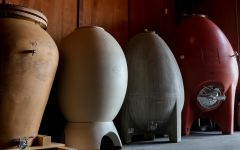Spottswoode Sauvignon Blanc 2021
-
Tasting
Panel -
Wine
Enthusiast -
Wilfred
Wong -
Robert
Parker -
Wine
Spectator -
Jeb
Dunnuck




Product Details
Your Rating
Somm Note
Winemaker Notes
Blend: 96% Sauvignon Blanc, 4% Sémillon
Professional Ratings
-
Tasting Panel
Fermented in a combination of French oak, small stainless- steel barrels, clay amphorae, and ceramic and concrete vats, this wine sees the addition of a small percentage of Sémillon: 57% of the fruit hailed from Sonoma County and 43% from Napa County. Citrus and floral aromatics float angelically above the glass as jasmine lights up the palate, glossing over white grapefruit, peach, and parchment. Sweet basil, tarragon, and freshly mowed grass are energized by vivid acidity
-
Wine Enthusiast
With 4% Sémillon, this bi-county white impresses in grapefruit,pea shoot and peach, with a hint of candied ginger on the back of the palate. Consistent acidity refreshes and adds complexity and refinement to the proceedings, with just a hint of oak.
-
Wilfred Wong of Wine.com
COMMENTARY: The Spottswoode Sauvignon Blancs have always found a special place on my palate. The 2021 vintage is, once again, at the top of its class. TASTING NOTES: This wine shines with aromas and flavors of dried herbs, ripe melon, and lemon peel. Pair it with a bowl of steamed clams in light garlic, jalapeno, and black peppercorn broth. (Tasted: June 9, 2022, San Francisco, CA)
-
Robert Parker's Wine Advocate
Sourced from eight different sites in Napa and Sonoma (it's labeled Napa County 43%, Sonoma County 57%), Spottswoode's 2021 Sauvignon Blanc was fermented in stainless steel barrels (50%), used French oak (25%), new French oak (20%) and other vessels (5%). The result is a complex, textural wine that's plump on the palate, round and silky, yet also bright, fresh, vibrant and long, with layers of fig and melon fruit that gradually unfold in the glass. I've been deliberately conservative with respect to its aging potential, but it's worth pointing out that a 2012 tasted at the winery was still drinking exceptionally well (91 points). Best After 2022
-
Wine Spectator
Complex, highly detailed and aromatic, but also shows a sense of elegance and poise. Offers lanolin, beeswax and lemon curd notes that mingle with dried mango, apricot and spices. Reveals lime zest, passionfruit and white pepper accents that linger on the long, expressive finish, with a fresh thread of acidity. Drink now.
-
Jeb Dunnuck
Always beautiful, the 2021 Sauvignon Blanc is another great vintage for this white. Medium-bodied and racy, yet also ripe, it has a great perfume of grapefruit and white flowers, with a kiss of background minerality. It’s impeccably made, and while I like this in its youth, it ages nicely for upwards of a decade if you’re so inclined.
Other Vintages
2022-
James
Suckling -
Wine
Enthusiast -
Wilfred
Wong -
Jeb
Dunnuck - Decanter
-
Wilfred
Wong -
Jeb
Dunnuck -
James
Suckling -
Robert
Parker
-
Wilfred
Wong -
Wine
Enthusiast -
Robert
Parker -
James
Suckling -
Jeb
Dunnuck
-
Robert
Parker -
Wilfred
Wong -
James
Suckling -
Wine
Spectator -
Wine
Enthusiast
-
Wilfred
Wong -
Wine
Enthusiast -
James
Suckling -
Robert
Parker
-
Wilfred
Wong -
James
Suckling
-
Wilfred
Wong -
James
Suckling
-
Wine
Enthusiast
-
Jeb
Dunnuck -
Robert
Parker
- Vinous
-
Jeb
Dunnuck







Spottswoode is an historic, family-owned estate vineyard and winery located on the western edge of St. Helena in Napa Valley. The estate was established in 1882 by George Schonewald, whose historic Victorian home is depicted on the label. Spottswoode was christened by Mrs. Albert Spotts, whose family owned the property from 1910 until its purchase in 1972 by Mary Weber Novak and her husband, Dr. Jack Novak. After Jack died unexpectedly in 1977, Mary carried out their shared dream, and Spottswoode’s debut Cabernet Sauvignon was produced in 1982, exactly one hundred years after the estate’s founding.
To ensure the highest quality, Spottswoode is dedicated to producing a handful of wines in very limited quantities: Spottswoode Estate Cabernet Sauvignon, Sauvignon Blanc, Lyndenhurst, and Field Book. The winery's goal is to produce exceptional, well-balanced, structured wines that exhibit texture, elegance, consistency and the ability to age well.
The 40-acre Spottswoode Estate Vineyard is an ideal terroir for growing wine grapes. Situated on the apex of the Sulphur Creek fan, the alluvial soils comprised primarily of sandy clay loam provide superb drainage. The gap between the Mayacamas Range and Spring Mountain admits cooling maritime breezes that temper the sun’s heat, creating an ideal microclimate for winegrowing. Among the first to introduce organic farming practices in the Napa Valley in 1985, Spottswoode is proud to have enjoyed the California Certified Organic Farmers (CCOF) certification since 1992 and Demeter Biodynamic Certification since 2020. Spottswoode is also Napa Valley’s first Certified B-Corp winery.

Capable of a vast array of styles, Sauvignon Blanc is a crisp, refreshing variety that equally reflects both terroir and varietal character. Though it can vary depending on where it is grown, a couple of commonalities always exist—namely, zesty acidity and intense aromatics. This variety is of French provenance. Somm Secret—Along with Cabernet Franc, Sauvignon Blanc is a proud parent of Cabernet Sauvignon. That green bell pepper aroma that all three varieties share is no coincidence—it comes from a high concentration of pyrazines (herbaceous aromatic compounds) inherent to each member of the family.

One of the world's most highly regarded regions for wine production as well as tourism, the Napa Valley was responsible for bringing worldwide recognition to California winemaking. In the 1960s, a few key wine families settled the area and hedged their bets on the valley's world-class winemaking potential—and they were right.
The Napa wine industry really took off in the 1980s, when producers scooped up vineyard lands and planted vines throughout the county. A number of wineries emerged, and today Napa is home to hundreds of producers ranging from boutique to corporate. Cabernet Sauvignon is definitely the grape of choice here, with many winemakers also focusing on Bordeaux blends. White wines from Napa Valley are usually Chardonnay and Sauvignon Blanc.
Within the Napa Valley lie many smaller sub-AVAs that claim specific wine characteristics based on situation, slope and soil. Farthest south and coolest from the influence of the San Pablo Bay is Carneros, followed by Coombsville to its northeast and then Yountville, Oakville and Rutherford. Above those are the warm St. Helena and the valley's newest and hottest AVA, Calistoga. These areas follow the valley floor and are known generally for creating rich, dense, complex and smooth red wines with good aging potential. The mountain sub appellations, nestled on the slopes overlooking the valley AVAs, include Stags Leap District, Atlas Peak, Chiles Valley (farther east), Howell Mountain, Mt. Veeder, Spring Mountain District and Diamond Mountain District. Napa Valley wines from the mountain regions are often more structured and firm, benefiting from a lot of time in the bottle to evolve and soften.
